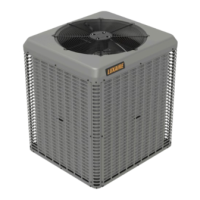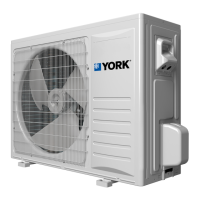Precautions during line installation
• Install the lines with as few bends as possible. Care
must be taken not to damage the couplings or kink
the tubing. Use clean hard drawn copper tubing
where no appreciable amount of bending around
obstruction is necessary. If soft copper must be
used, care must be taken to avoid sharp bends
which may cause a restriction.
• The lines should be installed so that they will not
obstruct service access to the coil, air handling
system, or filter.
• Care must also be taken to isolate the refrigerant
lines to minimize noise transmission from the
equipment to the structure.
• The vapor line must be insulated with a minimum
of 1/2 in. foam rubber insulation (Armaflex or
equivalent). Liquid lines that will be exposed to
direct sunlight, high temperatures, or excessive
humidity must also be insulated.
• Tape and suspend the refrigerant lines as shown. Do
not allow tube metal-to-metal contact. See Figure 3.
• Use PVC piping as a conduit for all underground
installations as shown in Figure 4. Buried lines
should be kept as short as possible to minimize the
build up of liquid refrigerant in the vapor line during
long periods of shutdown.
Figure 3: Installation of vapor line
• Pack fiberglass insulation and a sealing material
such as permagum around refrigerant lines where
they penetrate a wall to reduce vibration and to
retain some flexibility.
• For systems with total line length exceeding 80 ft
(22.86 m), refer to Piping Application Guide (P/N
247077) for vapor and liquid line sizing, calibration
of liquid line pressure loss or gain, determination
of vapor line velocity, elevation limitations, TXV
connections, system charging, traps, and crankcase
heater.
Figure 4: Underground installation
Precautions during brazing of lines
All outdoor unit and indoor coil connections are copper-
to-copper and should be brazed with a phosphorous-
copper alloy material such as Silfos-5 or equivalent. Do
not use soft solder. The outdoor units have reusable
service valves on both the liquid and vapor connections.
The total system refrigerant charge is retained within
the outdoor unit during shipping and installation. The
reusable service valves are provided to evacuate and
charge per this instruction.
Serious service problems can be avoided by taking
adequate precautions to assure an internally clean and
dry system.
CAUTION
Dry nitrogen should always be supplied through
the tubing while it is being brazed, because the
temperature required is high enough to cause
oxidation of the copper unless an inert atmosphere
is provided. The flow of dry nitrogen should continue
until the joint has cooled. Always use a pressure
regulator and safety valve to insure that only low
pressure dry nitrogen is introduced into the tubing.
Only a small flow is necessary to displace air and
prevent oxidation.
Precautions during brazing of service
valve
Precautions should be taken to prevent heat damage to
service valve by wrapping a wet rag around it as shown in
Figure 5. Also, protect all painted surfaces, insulation, and
plastic base during brazing. After brazing, cool joint with
wet rag.
R-410A Outdoor Split-System Heat Pump Installation Manual - YH2E / THE2 / RHP143 Series10
Johnson Controls Ducted Systems

